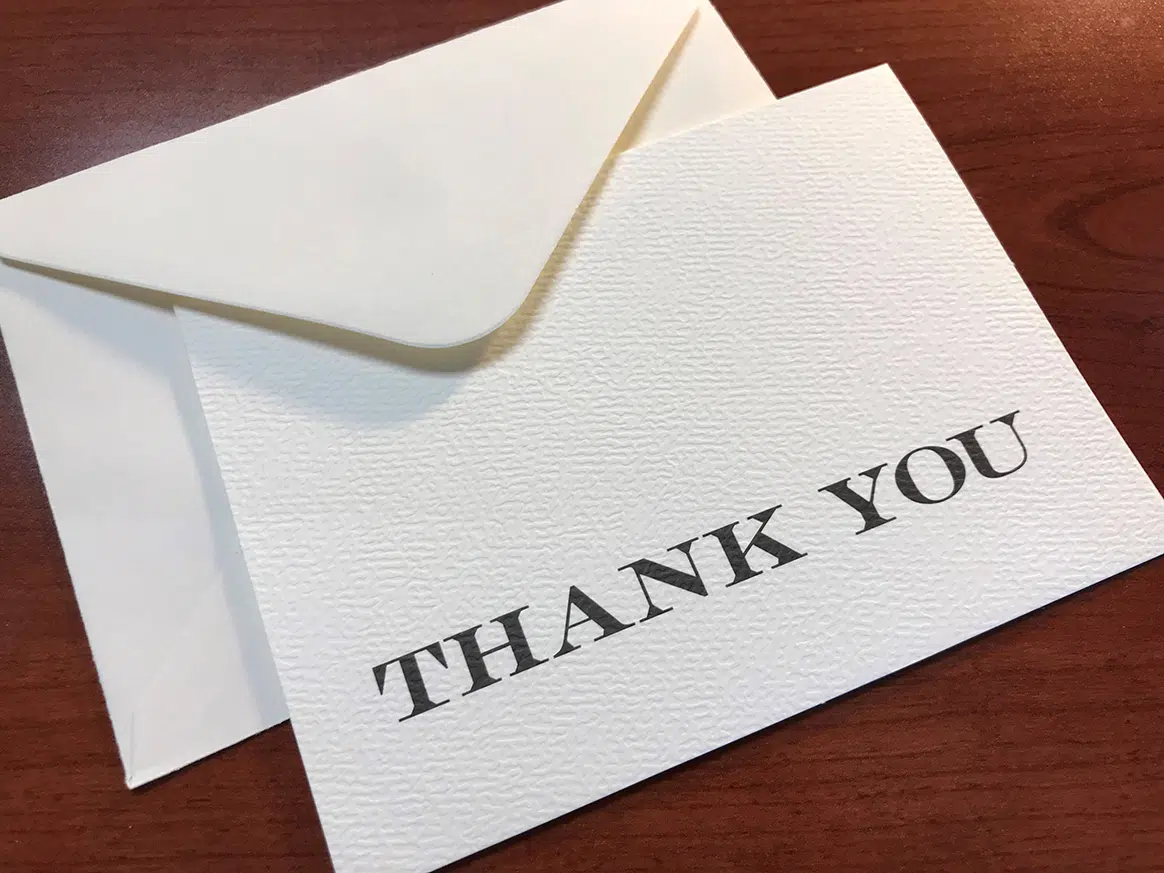Remember when you were young and your parents taught you how to write a thank-you note?
There even might have been a copy of Emily Post’s Etiquette book in your house. It was big and heavy —I remember walking around with it balanced on my head as practice for ballet class. Ok, you get the picture, it was all part of the “finishing” many of us went through to prepare us for adulthood — ballet, piano lessons, dance lessons, French classes, and, well, there was no point in sending me to singing lessons, I didn’t get that gene.
Thank-you notes were a big deal then. Aren’t they still or is the thank-you note a lost art?
Have you ever sent a gift to a younger friend or relative to wonder if it ever arrived or did the local porch pirate grab it? Now it’s easier to track a package through Amazon or the USPS, but you worry it was delivered but maybe never “received.”
In our house, thank-you notes were not optional and they usually weren’t tardy. The unspoken rule was that you wrote the thank-you note before you started using the gift. That was all the inspiration we needed. Write the note, do it from the heart and once it was in the mail stream — yes, snail mail, not email — you could use the gift.
When chatting with some friends recently, some bemoaned the fact that the only relationship they have with younger relatives is sending them gifts — birthday, Christmas, graduation, showers, weddings and baby gifts. They confided that often they don’t get a word of thanks or even an acknowledgement it arrived. Then they worry the gift wasn’t sufficient, wasn’t liked or worse, wasn’t appreciated.
We all probably can relate.
On the other hand, I have a friend who might overdo the thank-you note. Sometimes it feels like a tennis match. I drop off some baked goods and then she slips a thank-you note in our mailbox. Then she might leave some fresh fruit at our door, and I feel compelled to write to thank her and tell her how much we enjoyed it. A week or so goes by and there’s another random act of kindness, but always a follow-up note of thanks. It’s not a bad thing, but …
Our family etiquette book is long gone, but I happily discovered that the Emily Post Institute has a website — emilypost.com — with some great tips, they call “advice,” on being thankful. By the way, if you aren’t familiar with Emily Post, she was a Baltimore native who kept the people of the early 1900s in line with her writing. Oh, and etiquette is, according to Merriam-Webster (a dictionary), the conduct or procedure required by good breeding or prescribed by authority to be observed in social or official life. In other words, proper behavior.
“Get in touch with the sincerity of thanking people for thinking about you and sending you something — even if it’s a hot pink, polyester sweater,” the site reads. The thank-you note “is an appropriate gesture of respect and consideration.”
When should the notes be written? “As soon as possible … but a late note is always better than no note.”
What about an email thanks? “Email is okay to thank for a coffee or meal that was casual or whose invitation was extended by email in the first place. It’s also okay for very small favors. But for dinner parties, big favors, an actual gift, or being a houseguest, handwritten thank-you notes are your best bet for an expression of warm, heartfelt thanks.”
There are also tips for including creative things, such as photos of your kids using the gift, or turning an afternoon snack into a family note-writing event.
This part hit home for me. Take time to write thank-you notes. “Don’t try and wedge it in between laundry, a TV show, or extra work from the office. You’ll be able to think more clearly and your focus will translate to the page.” It’s true; you can tell the difference between a hastily written note and one you take your time with.
The website also has tipping advice, table-setting guidelines, lots of help for wedding etiquette and even an “Awesome Etiquette” podcast.
So, is all this good advice or too retro?
Drop me a note — email is fine — and share your thoughts.



Learn from the risen Lord